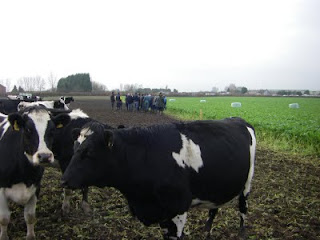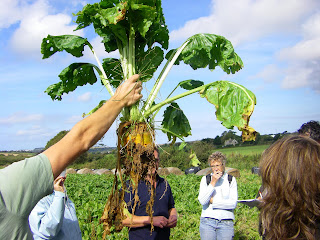



It never ceases to amaze me how some farmers make every day tasks really simple while others flog themselves to the point of exhaustion trying to make expensive complicated systems work. It seems a fact of life that complicated systems are always expensive.
The simple systems always seem to work better.
Winter feeding of housed milking dairy cows is a classic example.
Sadly most dairy farmers spend hours every day feeding their cows (& at huge cost). This makes winter one hell of a drag. It also often means that feeding becomes a specialised task. Once this happens individuals are trapped in a vicious cycle of having to do it as no one else knows how or could be trusted to do it right???
In amongst the "Pasture to Profit" dairy farm Discussion Groups in the UK there are smart people with smart simple ideas & simple ways of doing things. Its a matter of searching out these simple ideas & spreading them thru the groups so we move everyone onto a new more efficient plane. Few of these ideas are truely new but they have been adapted & modified on each farm.
Chris & Richard from the Wyegraze Group in Herefordshire have a simple winter feeding system that uses a silage block cutter & self feed manual barriers that the cows move themselves. The 400+ autumn calvers are ONLY fed grass silage once every ten days (varies). The Silage block cutter (see photo) ensures that the blocks in the barriers maintain their feed quality & the silage clamp face is near perfect(not letting any air into the silage). The capital costs are minimal as the Irish made barriers are a once only cost & relatively cheap. It's a simple diet ideal for a low input autumn calving system.
Sussex is the home of self feed silage. The 'vertical paddock' is low cost & effective with either grass or maize silage. Wastage is absolutely minimal. Calculations for issues like the required eating space for each milking cow have been carefully worked out by farmer experience.....good old 'suck & see' methods.
The 'Spratt silage feeding system for dry cows is a variation on the silage blocks(or bales). A simple system for feeding dry cows on concrete yards at virtually no capital expense & very little labour as dry cows need only be fed once a week(depending on the number of blocks/bales fed & the herd size). The feeding rate can be adjusted by how quickly the wire is moved.....this also controls wastage.
once a week(depending on the number of blocks/bales fed & the herd size). The feeding rate can be adjusted by how quickly the wire is moved.....this also controls wastage.
 once a week(depending on the number of blocks/bales fed & the herd size). The feeding rate can be adjusted by how quickly the wire is moved.....this also controls wastage.
once a week(depending on the number of blocks/bales fed & the herd size). The feeding rate can be adjusted by how quickly the wire is moved.....this also controls wastage.KEEP IT SIMPLE













































